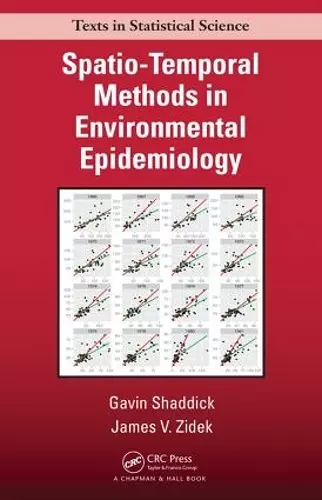Spatio-Temporal Methods in Environmental Epidemiology
Gavin Shaddick author James V Zidek author
Format:Hardback
Publisher:Taylor & Francis Inc
Published:24th Jun '15
Currently unavailable, and unfortunately no date known when it will be back
This hardback is available in another edition too:
- Paperback£42.99(9780367783464)

Teaches Students How to Perform Spatio-Temporal Analyses within Epidemiological StudiesSpatio-Temporal Methods in Environmental Epidemiology is the first book of its kind to specifically address the interface between environmental epidemiology and spatio-temporal modeling. In response to the growing need for collaboration between statisticians and environmental epidemiologists, the book links recent developments in spatio-temporal methodology with epidemiological applications. Drawing on real-life problems, it provides the necessary tools to exploit advances in methodology when assessing the health risks associated with environmental hazards. The book’s clear guidelines enable the implementation of the methodology and estimation of risks in practice.
Designed for graduate students in both epidemiology and statistics, the text covers a wide range of topics, from an introduction to epidemiological principles and the foundations of spatio-temporal modeling to new research directions. It describes traditional and Bayesian approaches and presents the theory of spatial, temporal, and spatio-temporal modeling in the context of its application to environmental epidemiology. The text includes practical examples together with embedded R code, details of specific R packages, and the use of other software, such as WinBUGS/OpenBUGS and integrated nested Laplace approximations (INLA). A supplementary website provides additional code, data, examples, exercises, lab projects, and more.
Representing a major new direction in environmental epidemiology, this book—in full color throughout—underscores the increasing need to consider dependencies in both space and time when modeling epidemiological data. Students will learn how to identify and model patterns in spatio-temporal data as well as exploit dependencies over space and time to reduce bias and inefficiency.
"The authors of this text, both accomplished researchers in the area, provide a much-needed consolidation of spatio-temporal modelling methods…The textbook condenses many complex topics into accessible and manageable chapters addressing key elements of modern spatio-temporal analyses of environmental epidemiologic data…The authors provide helpful R examples throughout…Analytic challenges such as missing data, measurement error, and preferential sampling often arise in environmental epidemiology and are each described in detail along with focused data examples and accompanying code…The text covers a remarkable number of topics in its 318 pages (including many full color graphics and examples of code and output). The structure outlined above provides excellent coverage of many areas of recent development, held together with compelling examples and illustrations…Overall, I found the book a comprehensive overview placing many different topics into a logical perspective with focused, helpful examples. I enjoyed reading the book, am already recommending it to colleagues, and anticipate referring to it often in my future work."
—Lance A.Waller, Emory University, The American Statistician, November 2016
"The authors of this text, both accomplished researchers in the area, provide a much-needed consolidation of spatio-temporal modelling methods…The textbook condenses many complex topics into accessible and manageable chapters addressing key elements of modern spatio-temporal analyses of environmental epidemiologic data…The authors provide helpful R examples throughout…Analytic challenges such as missing data, measurement error, and preferential sampling often arise in environmental epidemiology and are each described in detail along with focused data examples and accompanying code…The text covers a remarkable number of topics in its 318 pages (including many full color graphics and examples of code and output). The structure outlined above provides excellent coverage of many areas of recent development, held together with compelling examples and illustrations…Overall, I found the book a comprehensive overview placing many different topics into a logical perspective with focused, helpful examples. I enjoyed reading the book, am already recommending it to colleagues, and anticipate referring to it often in my future work."
—Lance A.Waller, Emory University, The American Statistician, November 2016
ISBN: 9781482237030
Dimensions: unknown
Weight: 1020g
400 pages